Construction of Target Controllable Image Segmentation Model Based on Homotopy Perturbation Technology
Abstract
Based on the basic idea of the homotopy perturbation method which was proposed by Jihuan He, a target controllable image segmentation model and the corresponding multiscale wavelet numerical method are constructed. Using the novel model, we can get the only right object from the multiobject images, which is helpful to avoid the oversegmentation and insufficient segmentation. The solution of the variational model is the nonlinear PDEs deduced by the variational approach. So, the bottleneck of the variational model on image segmentation is the lower efficiency of the algorithm. Combining the multiscale wavelet interpolation operator and HPM, a semianalytical numerical method can be obtained, which can improve the computational efficiency and accuracy greatly. The numerical results on some images segmentation show that the novel model and the numerical method are effective and practical.
1. Introduction
In general, choosing different parameters in the most common image segmentation methods usually leads to different image segmentation results [1]. In other words, the object segmentation results are uncontrollable by the common methods. To solve the problem, one of the most common strategies is choosing thresholds using prior knowledge or analyzing the distribution of gray values of an image with the gray value histogram. Another method is image enhancement, which can often destroy the contour of the objects.
The variational method on image segmentation is a new image processing technology, which processes lots of better properties in processing medical images such as MRI and CI [2]. In this method, the pictures are taken as continuous energetic fields, and so the corresponding information in digital images such as gradient, divergence, and the curvature of the object contour can be viewed as the differential operators embedded in the variational model on image processing. The traditional complicated image processing such as denoising with texture preserving and exact segmentation can be done by this model. The outstanding work of this field is the energy function for image segmentation proposed by Mumford and Shah, which has been widely used, and its mathematical properties are well analyzed. This is a general approach on image segmentation, where it is assumed that objects can be characterized by smooth surfaces or volumes in three dimensions. In order to solve the Mumford-Shah model with the Euler-Lagrange method, a simplified model was deduced by Chan and Vese, in which the Euclid length was employed instead of the Hausdorff length [3]. So, the simplified model is also called Chan-Vese model. Similar to other image segmentation methods, Chan-Vese model cannot identify the object as well. Multilevel set approach for solving C-V model can segment all the objects in a picture. But it will obviously lead to oversegmentation [4].
In many cases, the purpose of the image segmentation is to get one special single object instead of all the objects in a multiobject image. Therefore, the purpose of this paper is to construct a target controllable image segmentation model based on the basic idea of homotopy perturbation technology (HPM). Using the variational method, the optimal solution of the energy function can be expressed as a nonlinear partial differential equation. So, another task of this study is to construct an effective numerical method on nonlinear PDEs by combining the multiscale wavelet interpolation operator and the homotopy perturbation method. The homotopy perturbation method (HPM) proposed by He [5, 6] is constantly being developed and applied to solve various nonlinear problems by He [7–15] and by others [16–20]. The better improvement is adding an auxiliary parameter into the homotopy equation, which is helpful to eliminate the secular term in the perturbation solution. This can improve the rate of convergence greatly. Unlike analytical perturbation methods, HPM does not depend on small parameter which is difficult to find. The variational iteration method was another simple and effective method for nonlinear equations proposed by He [21–26], which can provide analytical approximations to a rather wide class of nonlinear equations [27–33] without linearization, perturbation, or discretization which can result in massive numerical computation. In order to solve the nonlinear PDEs, it is necessary to introduce the wavelet numerical algorithm [34–37] into HPM.
2. Construction of Target Controllable Image Segmentation Model
The solution of (4) is the level set function ϕ(x, y, t) at time t. The zero level set is the object contour curve, which can be obtained by solving ϕ(x, y, t) = 0.
Equation (11) is the target controllable image segmentation model. It should be pointed out that the auxiliary parameter α appearing in this model is set to zero, as there is no any secular term in the perturbation analytical solution.
3. HPM on Nonlinear System Based on the Multilevel Wavelet Analysis
3.1. Wavelet Numerical Discretization Schemes on C-V Model
Obviously, (15) is a nonlinear ordinary differential equation.
3.2. HPM on Discretization Format of C-V Model
4. Numerical Experiences and Discussion
In this section, we take some multiobject images as examples to illustrate the efficiency of the target controllable image segmentation model compared with the C-V model. The original image showed in Figure 1 consisted of three geometrical solid objects. The color of the background is white, and whole area is 1. The gray level values and the areas of the three objects are showed in Table 1. The image segmentation aims to get the circular and the rectangular objects. In other words, we want to take the black elliptical object as the background.
| Ellipse | Circle | Squareness | Background | |
|---|---|---|---|---|
| Gray level value | 0 | 163 | 7 | 255 |
| Area | 0.0568 | 0.0723 | 0.0733 | 0.7976 |
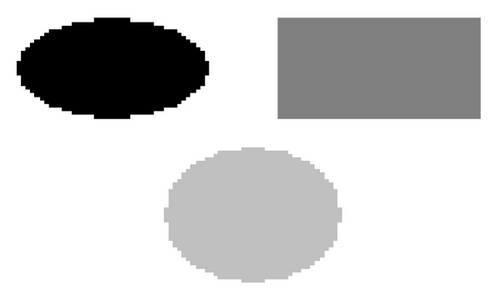
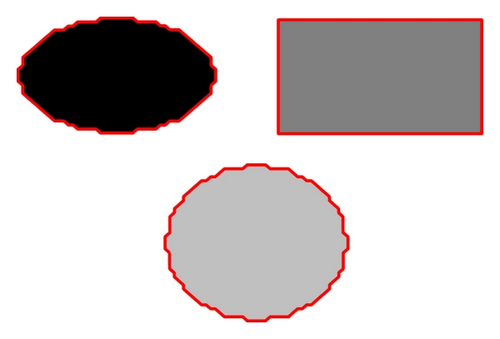
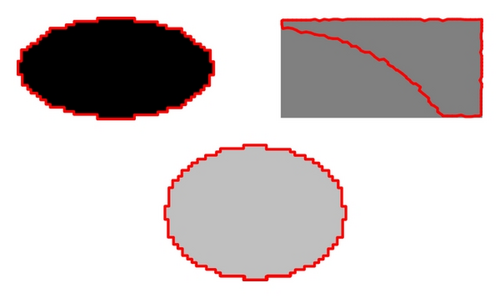
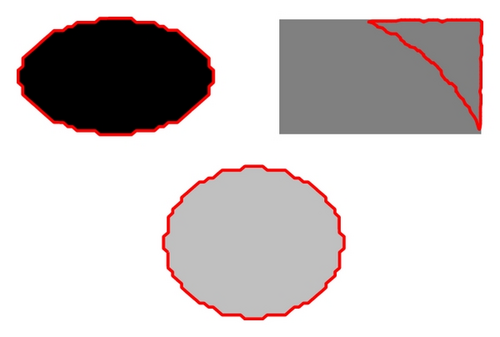
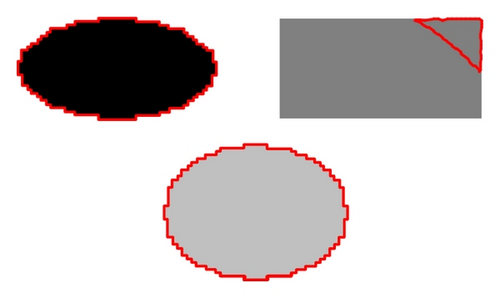

The segmentation results of C-V model are showed in Figure 1. With the increasing of the iteration times, the rectangular object becomes a part of the background gradually instead of the elliptical object, which does not meet our requirement obviously.
The segmentation results with the target controllable model are showed in Figure 2. The final c1 = 255 × 0.7976/(0.7976 + 0.0568) = 238.05, and c2 = (163 × 0.0723 + 7 × 0.0733)/(0.0723 + 0.0733) = 86.464. It should be pointed out that the final c1 and c2 can be obtained by priori knowledge in most cases. At the beginning of the segmentation, all the three objects are obtained as the foreground. With the increasing of the iteration times, the black object is gradually pushed into the background and out of the object region.
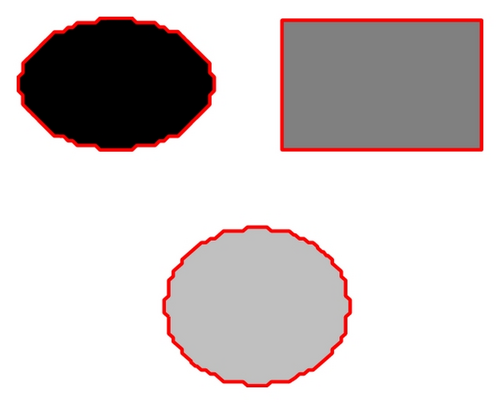
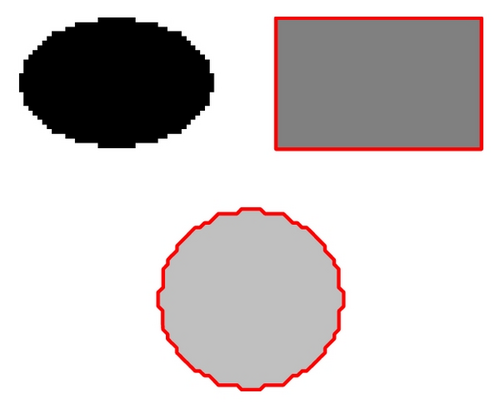
Figure 3 is an enlarged local image of the locust body cavity. The objects have an irregular shape with a slightly serrated border which can introduce over an insufficient segmentation. So it is difficult to segment with other methods. Using the target controllable model, we can get the right object easily. This example shows that the novel model and the corresponding numerical method are practical. Indeed, the novel model has been used to segment the locust’s coelom images (Figure 4).
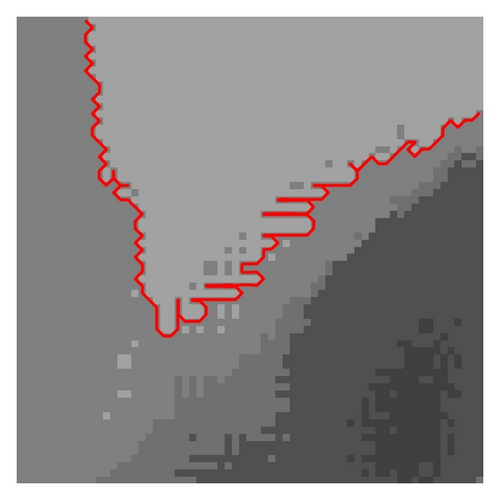
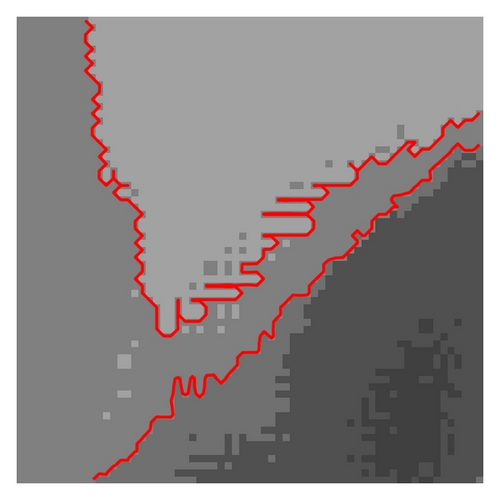
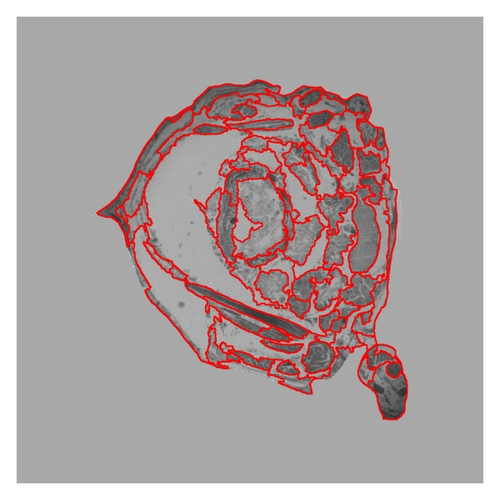
5. Conclusions
C-V model is a kind of the modified Mumford-Shah model which has been widely used in medical images, and its mathematical properties are well analyzed. But the segmentation result is usually uncontrollable. The target controllable image segmentation model proposed in this paper is based on the idea of HPM. The numerical experiences show that the novel model and the corresponding numerical algorithm are effective and practical. It meets the requirement of the medical images segmentation.
Acknowledgment
This work is supported by the National Natural Science Foundation of China under Grant no. 41171337 and National Key Technologies R & D Program of China under Grant no. 2012BAD35B02.




